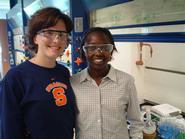
Vancomycin is an effective antibiotic that interferes with cell wall synthesis in bacteria. Because it is so powerful, vancomycin is only used after other antibiotics have failed in order to reduce the development of resistant bacteria; however, vancomycin-resistant bacteria have emerged despite these precautions. Gail Corneau '10 (Clifton Park, N.Y.) and Lydia Rono '11 (Eldoret, Kenya) are working with Assistant Professor of Chemistry Nicole Synder to develop a vancomycin derivative incorporating an unnatural carbohydrate to overcome this bacterial resistance.
Septanoses are seven member carbon rings that are not found in nature. Because bacteria cannot recognize septanoses, attaching a septanose to vancomycin may "confuse" bacteria and hopefully overcome their resistance to the antibiotic. Corneau and Rono are currently synthesizing the septanose they plan on attaching to vancomycin. To create the seven member ring, they are carrying out a nine step reaction that involves building a carbon chain of the appropriate length and closing it into a ring. Once the septanose is made, it will be tested to see if bacterial enzymes can recognize it. If the septanose passes the test and cannot be recognized, then it will eventually be attached to vancomycin. Corneau and Rono say that this is a completely new project and will probably take at least three years before it is completed.
This is Corneau and Rono's first summer of research. Corneau, a biochemistry major and pre-medical student, found this project interesting because it lies on the interface between biology and chemistry and has applications to human health. She is a member of Tumbling After and an avid horseback rider. Rono, a chemistry major, was drawn to the synthetic chemistry aspects of the project. She is a member of the track team, the West Indian and African Association (WIAA), and the Christian Fellowship.
-- by Nick Berry '09
Septanoses are seven member carbon rings that are not found in nature. Because bacteria cannot recognize septanoses, attaching a septanose to vancomycin may "confuse" bacteria and hopefully overcome their resistance to the antibiotic. Corneau and Rono are currently synthesizing the septanose they plan on attaching to vancomycin. To create the seven member ring, they are carrying out a nine step reaction that involves building a carbon chain of the appropriate length and closing it into a ring. Once the septanose is made, it will be tested to see if bacterial enzymes can recognize it. If the septanose passes the test and cannot be recognized, then it will eventually be attached to vancomycin. Corneau and Rono say that this is a completely new project and will probably take at least three years before it is completed.
This is Corneau and Rono's first summer of research. Corneau, a biochemistry major and pre-medical student, found this project interesting because it lies on the interface between biology and chemistry and has applications to human health. She is a member of Tumbling After and an avid horseback rider. Rono, a chemistry major, was drawn to the synthetic chemistry aspects of the project. She is a member of the track team, the West Indian and African Association (WIAA), and the Christian Fellowship.
-- by Nick Berry '09
